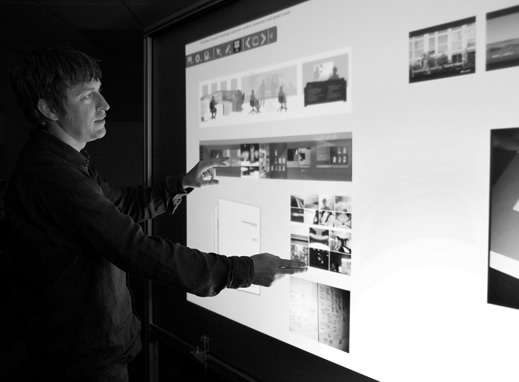This Fall term, Art Center took another step in its evolution and launched an Interaction Design (IxD) degree program headed up by user experience pioneer Maggie Hendrie.
Now, wait a minute, you might be thinking, hasn’t the College been teaching interaction design for years? After all, Art Center has alumni working at Google, Microsoft, Samsung and virtually every company exploring the boundaries of interactivity.
The answer to that, of course, is yes, Art Center has indeed been preparing its graduates to enter the field of interaction design for the better part of two decades.
“Art Center has a long history of maintaining the dynamic between the development of a craft and the application of it, and interaction design is an applied craft,” Hendrie recently told The Dotted Line. “Also, Art Center is already outstanding in the very fields in which interaction is applied: environments, interfaces, products, automotives, social projects and systems.”
Take for example alumnus Ian Sands, the co-founder of vision and strategy firm Intentional Futures, who graduated from the College in 1995 with a degree in Product Design.
Sands began his Art Center career focusing on ergonomic challenges in the physical world, but felt drawn to work in the digital space. (To keep things in perspective, remember that Netscape launched version 1.0 of its Netscape Navigator web browser in December 1994!)
After taking several software courses and participating in a Samsung sponsored project focused on the interactive potential of television, Sands—along with his future Intentional Futures colleague Brandon Sincock GRPH 95—convinced their department chair to allow them to create a self-made curriculum emphasizing software, 3D modeling, industrial design, motion graphics, graphic design and photography.
After graduating from Art Center, Sands went immediately to Microsoft, where he helped launch Slate.com, MSNBC, the Microsoft Store and where he eventually created and led the software giant’s Envisioning research group, which articulated the long-term potential of Microsoft’s technologies (see Future Vision 2019 video below).
And through it all, Sands credits Art Center with instilling him with the confidence to succeed. “I knew I had the tools to do it and could voice my opinions on the strategy,” said Sands in a recent Dot Magazine profile Hybrid Thinker, Imaginative Realist. “Art Center taught me that I could handle the pressure and still do a good job.”
In 2010, Sands left Microsoft and started up his own consultancy, Intentional Futures, which, among other projects, is working closely with historian David Christian (see video below) and Microsoft founder Bill Gates’ to launch The Big History Project, an interactive high school curriculum whose aims are no less ambitious than exploring 13.7 billion years of history.
Tackling a project as wide-ranging as The Big History Project also requires a set of skills that Art Center has also long taught its students: storytelling, problem solving and empathy.
“The ability to tell stories is huge,” said Product Design faculty Jeff Higashi—who, along with Brian Boyl and Phil van Allen, helped Art Center prepare for the creation of the Interaction Design program. “It’s a tool that really helps create a better experience. In our classes, we continually rewrite and refine stories every week to make sure we’re addressing desirable needs.”
Hendrie describes interaction designers as people who find alternative ways of understanding, describing and solving problems in areas like work, play and lifestyle. “As designers, we don’t wait for people to tell us what they want us to create,” said Hendrie. “We start by observing—watching what people do in their world. We’re always looking for insights that bring us to that ‘imagine if’ question.
“And every step of the way, we’re envisioning the people who we’re designing for—’What are they thinking? How are they feeling? What are they doing?’” she adds. “A lot of innovation comes from empathizing, then prototyping different kinds of solutions.”
Art Center is now accepting applications for students entering the Interaction Design program. For more information, call Admissions at 626.396.2373 or visit artcenter.edu/ixd









